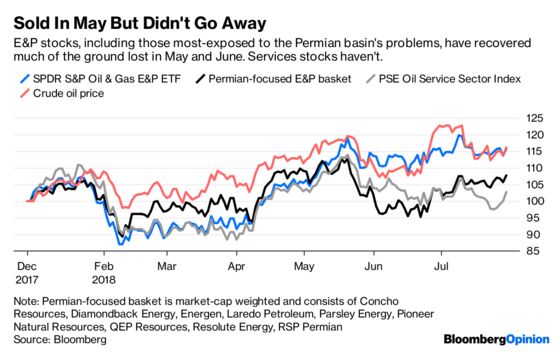The Permian Isn’t a Driller Killer
Guilt By Permian Association Hits Drillers Too Hard
(Bloomberg Opinion) -- When the Permian basin sneezes, the U.S. oil and gas sector catches a cold. More accurately, the Permian has a nasty dose of congestion. Also more accurately, some in the industry have stronger immune systems than others.
Exploration and production stocks that sold off in mid-May, as pipeline constraints started hitting the price of Permian barrels, have staged something of a comeback.

Services stocks haven’t fared as well. To a degree, this makes sense. Almost half the rigs operating on land in the U.S. are in the Permian basin; it also accounts for more than a third of wells being completed (fracked, essentially) in major tight-rock basins. If lower local oil prices force slower development in the region, then naturally the companies providing the equipment and bodies will suffer first. Look at Halliburton Co., where recent talk of slower activity weighing on pricing in its completions business prompted the worst one-day drop in the stock since the oil crash began.
The temporary nature of the Permian’s constraints, along with Halliburton’s other strengths, made that sell-off look overdone (see this). Similarly, some drilling stocks have taken too much of beating.
While it is obvious that fracking in the Permian basin must slow over the next 12-18 months, drilling is more nuanced. That’s partly because drilling typically accounts for about a third of the cost of a well, versus almost two-thirds for completion. So pressure-pumpers in the business of fracking get hit first when producers are struggling to find space on a pipeline and/or trying to conserve cash. What’s more, rigs tend to be contracted on a longer-term basis, and the planning and construction process for drilling operates on a longer cycle than completions. For E&P companies, that means they must weigh the benefit of pulling back on drilling due to the Permian’s issues versus the drag on efficiency (read: cost per barrel) from messing with the schedule.

This makes the noises coming out of land drillers such as Helmerich & Payne Inc. and Patterson-UTI Energy Inc. a bit easier to understand. While they acknowledged the Permian pain factor on earnings calls last week, they also reported resiliency in contracting and pricing for rigs, especially higher-end “super-spec” rigs. The latter can drill longer horizontal wells and move quickly from well to well to speed things up, making them perfect for E&P companies trying to push unit costs lower (see this for more details).

Yet land drillers have suffered some of the biggest drops in their stock price since mid-May, with Helmerich & Payne down by 14 percent and UTI-Patterson and Nabors Industries Ltd (which reports results Tuesday evening) having fallen almost 30 percent.
Helmerich & Payne, with its substantial lead in super-spec rigs, retains its premium valuation at almost 12 times 2018 Ebitda. Nabors is at a more reasonable 7.5 times. UTI-Patterson, meanwhile, suffers a heavier discount because of its pressure-pumping business, which will drag on earnings and sentiment at least through the rest of this year. That said, at 5.7 times Ebitda, it is priced similarly to much harsher periods in the past few years, such as early 2016. That hole looks too deep.

To contact the editor responsible for this story: Mark Gongloff at mgongloff1@bloomberg.net
This column does not necessarily reflect the opinion of the editorial board or Bloomberg LP and its owners.
Liam Denning is a Bloomberg Opinion columnist covering energy, mining and commodities. He previously was editor of the Wall Street Journal's Heard on the Street column and wrote for the Financial Times' Lex column. He was also an investment banker.
©2018 Bloomberg L.P.